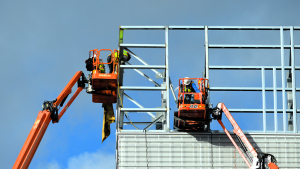Cross-examination of the expert witness reveals the extent to which an expert witness’s opinion is overstated or unwarranted: “The opinion of an expert who is too eager to please, too keen to produce a report that is helpful, will almost always unravel on the stand….”
Hired gun misses the target: court rejects evidence of expert witness whose approach is not independent
by Michael MacKay
Negligence • contractors and subcontractors liable to owner for negligent construction that poses a danger to the safety of building’s occupants • Expert Witnesses • duty to be impartial • court may reject evidence of expert witness whose testimony crosses the line into advocacy on behalf of his or her client • Damages • remedial measures • plaintiff not required to use novel techniques or approach to remedy dangerous structure
Loblaws Inc. v. United Dominion Industries Ltd.
Introduction
The Centrac Warehouse, a single storey 24-foot high, flat roofed 120,120 square foot building, was built in 1973 using open web steel joists fabricated, delivered and installed by Robb Engineering, a subsidiary of United Dominion Industries.
On January 27, 1995 a portion of the roof of the Centrac Warehouse collapsed. At least three open web steel joists collapsed onto the top of the warehouse’s internal racking system three feet from the ceiling. This fortunately prevented a more extensive collapse. Naturally, the collapsed area was repaired.
In the summer of 1995, the owner Loblaws prudently commissioned Structural Consultants Limited to inspect the whole building.
Loblaws sued United Dominion Industries for the costs to repair the joists in that part of the warehouse that didn’t collapse.
The Supreme Court of Canada in 1995 in Winnipeg Condominium Corporation No. 36 v. Bird Construction established that contractors and subcontractors have a duty to ensure that their buildings do not contain defects that “pose a substantial danger to the health and safety of the occupants” and are liable for:
…the reasonable cost of putting the building into a non-dangerous state, but not the cost of any repairs that would serve merely to improve the quality, and not the safety, of the building.
In this case, Robb Engineering clearly owed a legal duty of care to Loblaws, which it breached when it supplied defective joists. The trial was over whether Loblaws’ remediation program was reasonable.
Since this was principally an engineering issue, the outcome depended largely on the evidence of professional engineers and other expert witnesses.
The Law of Expert Evidence
Before she considered the evidence itself, Justice Dunn reviewed the legal principles governing the reception of expert evidence. (Generally witnesses at trial can only testify to facts within their personal knowledge, and are not allowed to express opinions, because it is the court’s job to draw whatever legal conclusions or make whatever inferences it can from the evidence. For instance, a witness to a motor vehicle accident case will not be permitted to state that, in his opinion, the defendant was negligent, or even whether the defendant was driving “too fast.” That is the judge’s job.)
Expert witnesses are an exception: the court admits expert opinion (i.e., non-factual) evidence to help it understand evidence outside the judge’s common experience and knowledge. The expert is necessary because the judge cannot without help assess the facts and perform the specialized and technical analysis necessary to reach an informed conclusion.
The expert witness is thus in a unique position, a witness upon whom the unqualified judge may rely in making a finding that may have significant import for the parties to the litigation.
Because the judge is not qualified to assess the accuracy of the expert’s opinion — the judge evaluates expert evidence accordingly by assessing the credibility of the expert.
For this reason, it is critical that the expert refrain from partisan advocacy and not present argument in the guise of expert evidence. Justice Dunn stated:
…an expert owes a particular duty to the court… not just to tell the truth, which is a duty of all witnesses, but a duty to be true to his or her profession or discipline when offering opinions within that discipline. Thus, regardless of which party may produce a particular expert, the fact that such expert is qualified to give opinion evidence means that the opinion will be founded only in the training and experience of the expert and not in the exigencies of litigation or in the interest of the party in question.
…this principle that underlies the prohibition against an expert being an advocate…. An expert does not argue for or against a party. Rather, the expert is guided by and only by his or her particular discipline whether or not the conclusions suggested by that discipline advance the cause of the party who retained the expert.
To be a credible,
…neutral observer who assists the court in interpreting complicated factual matters, an expert witness must retain an air of objectivity and a semblance of independence from the hiring party…. The lawyer who refrains from drawing his or her own expert into the role of the ‘hired gun’ will be rewarded in the long run because the court will be more inclined to give greater weight to expert testimony not tainted by advocacy.
Cross-examination of the expert witness reveals the extent to which an expert witness’s opinion is overstated or unwarranted: “The opinion of an expert who is too eager to please, too keen to produce a report that is helpful, will almost always unravel on the stand….”
The Remedial Work at the Centrac Warehouse
Lloyd Short, a professional engineer with Structural Consultants Limited testified as to the inspection and the remedial measures. They inspected 151 of the 450 open web steel joists (over 30%) and found that:
- 89 per cent exhibited some sweep, in most cases significant sweep;
- 69 per cent had at at least one defective weld;
- 50 per cent had defective web members;
- 48 per cent had defective chords; and
- only two of the 151 joists were defect-free.
As a result, in 1995, they recommended to Loblaws:
In light of the extent and random nature of the roof joist defects and in particular the difficulty in determining the location of cracked weld joints particularly at the top chord, it was decided to reinforce all welded joints.
In addition the consistent inferior quality of welding played a role in making the decision to reinforce all joints.
In essence, the trial was about whether Structural Consultant’s recommendation to reinforce all welded joints was justified.
In September 1997, the Newfoundland and Labrador provincial government’s Open Web Steel Joist Task Review Board (created to perform a comprehensive investigation into Robb Engineering’s steel joists, which had been used in many buildings throughout the province) released its Final Report on “Open Web Steel Joist Load Testing and Inspections”. Its mandate had been to:
…determine the minimum reasonable level of remediation or repair that must be performed in order to have confidence that the structures meet the intention of current codes and standards with respect to strength, stability, integrity and safety. [Emphasis added.]
Lloyd Short acknowledged that the Centrac Warehouse was remediated to a higher level than Task Force’s recommendations, but there were two reasons.
First, the welding and other problems in the Centrac Warehouse were much worse than average:
- 69 per cent of the warehouse’s joists had one or more broken welds, compared to 8.3 per cent of all Robb Engineering joists fabricated in 1973;
- 48 per cent of the warehouse’s joists had buckled top chords, compared to the provinces average of 3.2; and
- 50 per cent of the warehouse’s joists had bent webs, compared to the province’s average of 4.6 per cent.
Secondly, Structural Consultants believed that it would be cheaper to simply reinforce all the welds than to inspect every weld and then fix just the defective ones. Lloyd Short testified that:
It was to some degree an economic decision. We could spend more time looking at a weld, each and every weld, and it would be quicker for the welder to weld it than have us prodding and prying, and saying do ninety percent and leave these ten, and the less chance of error, and for all those reasons.
Loblaws’ Experts
Two expert witnesses testified for Loblaws on the reasonableness of its remedial measures.
Gary Follett, a welding engineer, testified to the quality of the welding of the Centrac Warehouse joists. He specifically criticized Robb Engineering’s use of “puddle welds” because puddle welds had never been certified:
…a ‘puddle weld’ is not a recognized joint configuration in CSA W59.1-1970…. The significant trait of a puddle weld is its minimal effective length and defective throat. Welding is concentrated to the ends of the web members and does not extend longitudually. The resulting weld is of poor quality and undefined strength. [Emphasis added.]
Dr. Ralph Southward, an expert on the standards and regulations governing welding, particularly CSA W47 and CSA W59, concluded that “the welding of open web steel joists at Robb Engineering did not come even remotely close to meeting the requirements or intent of CSA Standard W59.” His report said:
At no time in my professional career have I witnessed such a blatant disregard for the obligations imposed upon a steel fabricator, Certified by the Canadian Welding Bureau to CSA W47, as displayed by Robb Engineering when producing open web steel joists.
Based on the limited information available in 1995 it was reasonable for Loblaws to undertake the remedial program it did, because:
Structural Consultants Limited had no quantitative basis upon which to evaluate the capacity of the existing Robb Engineering joist welds. The Newfoundland Government Open Web Steel Joist Task Review Board had not yet been established and the results of their testing program were unavailable.
United Dominion Industries’ Experts
Basically, United Dominion Industries took the position that Loblaws should have done no more than what the Task Force subsequently determined was necessary, and:
…set out to prove, through its expert, Dr. Laurie Kennedy, that … the majority of the welds were of sufficient quality to bear the loads for which they were designed.
Dr. Kennedy pointed out that just because the “puddle weld” had not in fact been approved, that did not mean it was not an acceptable weld: “The question about the puddle welds is what loads can they carry?” Just because the welds were bad, cracked, or even missing altogether, that this constituted a dangerous defect. The proper approach would be to actually measure the strength of the remaining welds to determine if the actual roof structure was sufficient to meet code and safety requirements.
Critical to United Dominion’s argument was the proposition that it was actually possible to measure the strength of the top chord welds. Justice Dunn found that Dr. Kennedy’s evidence fell short of establishing this.
At trial, Dr. Kennedy testified that the top chord welds could be adequately tested by use of a mirror, pry bar and finger manipulation. However, many of the other witnesses contradicted this opinion. More significantly, Dr. Kennedy’s own conduct contradicted his opinion. In 1995, he participated in the development and testing of a device for testing open web joist welds, saying:
Because web-to-top chord welds were inaccessible, the desirability of being able to test these welds in-situ to obviate expensive remedial work became obvious.
If top chord weld strength could be determined with a mirror, pry bar and finger, there would be no need for Dr. Kennedy to work on a device to actually measure them.
To be received as expert evidence, the science on which it is based must be “generally accepted” in the scientific community. By the same principle, the court would not impose upon a plaintiff such as Loblaws the obligation to perform remedial work using methods or technologies that had not been generally accepted by the engineering community. Justice Dunn said:
Based on the evidence before me, I would classify the two mechanical devices [developed by the defendant’s experts] as novel techniques… particularly in that no evidence has been advanced to establish that the devices have either been subject to peer review or have been accepted in the industry as a reliable mechanism for testing top chord welds.
Justice Dunn did not impugn Dr. Kennedy’s honesty, calling him “…an individual who appears to have a genuine belief that he has something significant to offer the Court as to the welding in the Centrac Building.” She said, however, that:
Dr. Kennedy is still in the process of attempting to find a way to prove the repair of individual welds, which clearly evidence problems, is a sufficient way to address the dangers of roof collapse created in the Robb Engineering open web steel joist systems found in numerous buildings throughout the Atlantic Region. Dr. Kennedy’s evidence lacks the objectivity expected by a Court in relying upon an expert.
She concluded that Dr. Kennedy was no more than a “hired gun” retained “to assign legal responsibility for the defects away from the defendant” for several reasons.
Justice Dunn’s rejection of the defence expert opinions left Loblaws’ experts’ opinions “virtually uncontradicted.”
Justice Dunn was satisfied that Loblaws proved its remediation was “reasonable at the time” it was undertaken. While in hindsight, it may be that the remediation went beyond what was required. Loblaws did not have the benefit of hindsight nor the Task Force testing results in 1995 when it was making a determination as to how the building ought to be remediated. It would have cost more to inspect all the welds than to simply reweld them all.
Justice Dunn found comfort in the earlier trial decision, Carleton Condominium Corp. No. 21 v. Minto Construction Limited, a similar case involving moisture penetration of a masonry building envelope that had to be completely replaced, where the trial judge had said that, in responding to the discovery of the contractor’s negligence, the owner
…was only required to act like a reasonable and prudent person. The steps taken should not be put under a microscope to see if any other course of action would have been more efficacious, cost effective or fruitful.
Having found United Dominion Industries fully liable, Justice Dunn left it to the parties to agree to the amount of damages; if they could not, she would hold a hearing to assess them.
Newfoundland and Labrador Supreme Court
Dunn J.
February 16, 2007










Recent Comments
comments for this post are closed